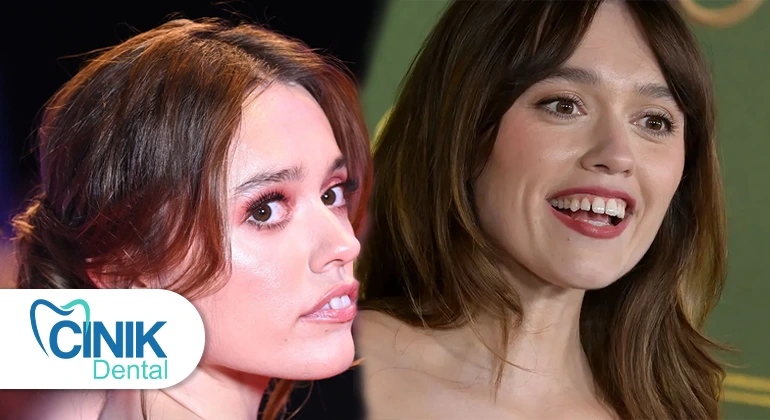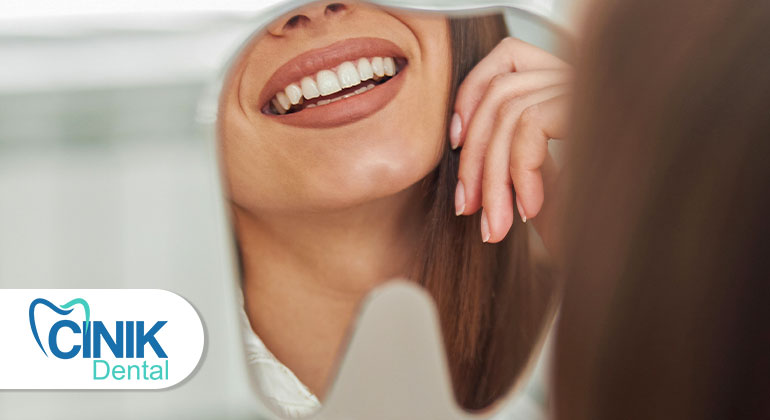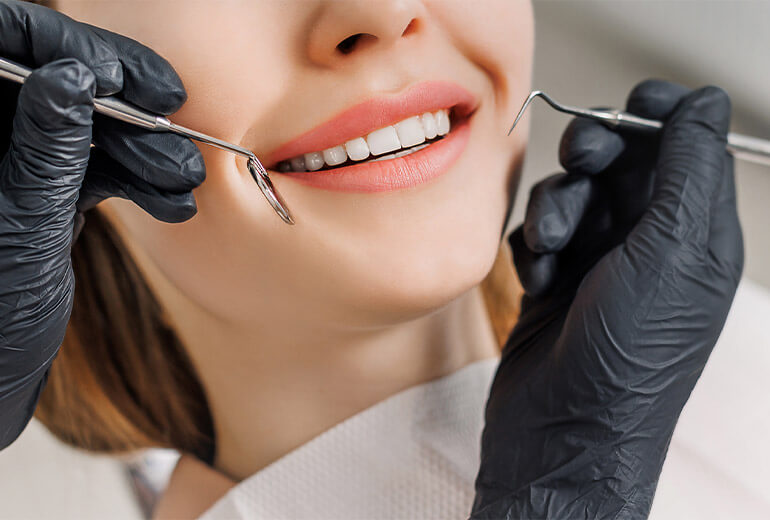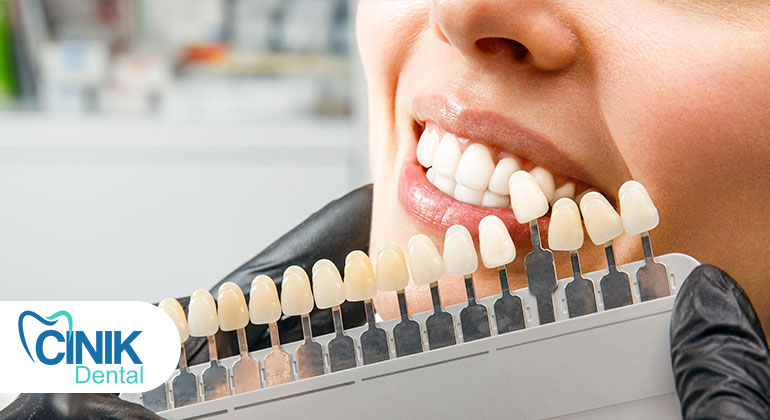Aimee Lou Wood’s Teeth: When Natural Is Better
In our today’s world, obsessed with filters, veneers, and straight white smiles, Aimee Lou Wood seems a breath of fresh air. This famous British actress, known for her roles as Aimee Gibbs in Sex Education and Chelsea in White Lotus, has become an unlikely poster girl for a growing movement: embracing imperfections. Or, better said, realizing that your “imperfections” were never flaws in the first place.
Yes, we’re talking about Aimee Lou Wood’s teeth — more specifically, what some refer to as her “buck teeth.” It’s a topic that’s sparked curiosity, admiration, and a refreshing amount of self-reflection. In an era of cookie-cutter smiles, Aimee’s unapologetically natural teeth are making a statement that many of us didn’t know we needed to hear.
There’s a reason why Aimee Lou Wood’s smile is the talk of the internet: it’s real. In a sea of surgically perfected faces, Aimee Lou Wood’s natural smile, often referred to online as “Aimee Lou Wood’s buck teeth,” has quietly revolutionized beauty.
People are wondering why Aimee Lou Wood has buck teeth—just because she belongs to the group where a glistering, perfect smile has long become a must-have. The answer is simple. Aimee Lou Wood’s buck teeth give her a unique and refreshing appearance. (Well, not to mention her impressive talent.)
But perhaps the better question is, why are we often so obsessed with fixing what was never broken?
The Smile That Stands Out
For anyone who’s watched Sex Education, Aimee Lou Wood’s character, Aimee Gibbs, is unforgettable. She doesn’t look like every other young actress on Netflix. She definitely stands out as an actress. Her charm lies in her authenticity, and yes, in her teeth.
Her front teeth are prominent, spaced slightly apart, and curve gently forward — features that some would label as “buck teeth.” But far from being something she hides, Aimee leans into them. And we’re all better for it.
In an interview with Elle UK, she openly discussed her insecurities growing up:
“A big thing for me growing up was my mouth because it was the thing that everyone pointed out, and it was the thing that made me different. And I’ve never seen an actress on TV with teeth like mine.”
— Elle UK
The quote resonated with thousands, especially young women and men who’ve spent their lives hiding their smiles behind closed lips.
“Does Aimee Lou Wood Have Buck Teeth?” – And Why That’s the Wrong Question
Let’s address the terms head-on. Yes, if you’re asking whether Aimee Lou Wood’s teeth fit the dental definition of an “overjet” (commonly known as buck teeth), then technically, they do. But framing it in this way misses the point.
What people are really reacting to is the fact that her teeth deviate from the hyper-perfect standards set by celebrities, influencers, and social media filters. And instead of correcting that deviation with braces, veneers, or digital edits, Aimee has embraced it.
Why does this feel so radical? Because we’ve been conditioned to believe that anything outside the norm must be “fixed.”
When Georgia May Jagger Helped Change Everything
Aimee recalls that one of the first times she felt empowered to embrace her smile was during a famous campaign by model Georgia May Jagger.
“When Georgia Jagger did ‘get the London look,’ and she had the gap teeth, that was a huge moment. And I thought, ‘No, I am going to put red lipstick on, and I am going to draw attention to it.’”
— Elle UK
In response, Jagger left a comment on Aimee Wood’s post, calling her teeth “gorgeous”.
It was a defining shift — from hiding what made her different to highlighting it. And for viewers watching Aimee on screen today, it’s equally transformative.
The Hollywood Veneer vs. British Realism
Fans of The White Lotus do remember the series opener, when Chelsea, Aimee Wood’s character, hears a compliment on her teeth. Chloe, played by the actress Charlotte Le Bon, starts the conversation with her future friend by saying: “I love your teeth. You’re from England, right?”
By the way, this phrase was an impromptu! As Aimee Wood recalled later, “It wasn’t in the script. Charlotte improvised that, because she was obsessed with my teeth.”
— The Face
Mike White, the creator of The White Lotus, included this line into the script – and it worked out well. This remark turned into one of the cutest moments of the season.
In her numerous interviews, Aimee often points out the difference between American and British beauty standards. In the UK, natural teeth are far more common and less stigmatized. In America, especially in show business, straight white teeth are practically non-negotiable.
“I also don’t look very American. I always think my teeth just give me away as someone from England.”
— Elle UK
When cast in The White Lotus, Aimee Lou Wood stood out again — not just because of her talent, but because she looked like a real person among a sea of Hollywood faces. And people noticed.
Here are just a couple of typical comments (out of hundreds):
“I’ve always been self-conscious about my teeth, and then I saw Aimee Lou Wood on Sex Education. She’s stunning — and suddenly I didn’t feel so bad about my own smile.”
“She made me cancel my orthodontist appointment. I realized I didn’t have to fix something.”
But What Do Dentists Say? A Medical Viewpoint
Dr. Eda TINAŞ from our team at Cinik Dental genuinely admires Aimee’s confidence. Her choice to embrace her natural teeth is uplifting and, quite honestly, inspiring. That said, it’s worth exploring the other side of the conversation — not to criticize, but to inform.
While many people with prominent front teeth, or overjets (that’s the technical term for it), live their whole lives without a single issue, there are cases where these dental features can lead to problems.
So, what exactly is an overjet? It’s when the upper front teeth stick out past the lower front teeth, creating a horizontal gap. This is different from an overbite, which is more about the vertical overlap of the top and bottom teeth. Overjets can vary in severity — from a slight projection that’s barely noticeable to a more evident one, affecting how the teeth come together.
In mild cases — like what we see with Aimee — it’s often just a unique part of someone’s appearance. But if the overjet is more pronounced, it can create a range of functional challenges, including:
Difficulty chewing certain foods
When the front teeth don’t align well, biting into things like apples, sandwiches, or even pizza can be tricky. The teeth just don’t meet in a way that lets you tear or cut food easily.
Speech impediments
Some people with larger overjets develop lisps or have trouble clearly pronouncing certain sounds, e.g., “s” and “th”.
Increased risk of dental trauma
Protruding teeth are more exposed, which means they’re more likely to be injured — especially during falls, accidents, or in contact sports. It’s a bit like parking your car halfway out of the garage — it’s more likely to get bumped.
Jaw strain and TMJ (temporomandibular joint) problems
The jaw works hard to compensate when the bite isn’t properly aligned. Over time, this can lead to tension, discomfort, or clicking in the jaw joint.
Tooth wear and enamel erosion
Misaligned bites can cause the teeth to grind in unnatural ways. This might wear down the enamel unevenly, which increases sensitivity and can eventually lead to decay or chipping.
Now, before anyone panics — this doesn’t mean everyone with slightly protruding teeth is on a collision course with dental disaster. Not at all.such issuest of these issues only arise when the overjet is significant or when it’s paired with other bite problems, such as crowding, crossbites, or jaw misalignment.
For someone like Aimee, who shows no signs of discomfort, jaw tension, or speech difficulty, there’s no medical problem. Her smile works perfectly fine — and looks fabulous, too. In cases like hers, we often say: If it causes no trouble, don’t fix it.
Dentists and orthodontists always look at the whole picture before making any recommendations. Is the bite functional? Is the patient in pain or embarrassed about themselves? Are the teeth wearing down abnormally? If the answer is no to all of those, there’s usually no strong reason to pursue treatment — unless the person simply wants to make a cosmetic change, and that’s entirely up to them.
Some patients are surprised to learn that their “imperfection” isn’t considered a medical issue at all. We often reassure them that not all dental quirks need correcting—especially if they’re not causing discomfort or health concerns. After all, some of the most memorable smiles in the world come from the very things that make us different.
Of course, we always recommend regular checkups to make sure things stay that way. Even natural quirks can evolve over time, so keeping an eye on things with your dentist is a smart move. But remember, “unusual” doesn’t automatically mean “unhealthy.”
All in all, the only aim of dental care should be your health and your happiness. For some, that means aligners and adjustments. For others, like Aimee, it means embracing a smile that’s all their own — and showing the world that different can be delightful.
If Aimee Wanted to “Fix” Her Teeth – What Would the Options Be?
Well, if someone with a smile similar to Aimee’s, did want to explore treatment options, here’s what they might consider:
- Orthodontics (Braces or Clear Aligners)
The most common way to treat an overjet. Aligners like Invisalign are popular with adults, offering subtle correction over time without visible braces.
- Veneers or Cosmetic Bonding
This doesn’t correct the bite but can improve the appearance by reshaping or covering the front teeth. It’s quick but can be expensive and requires long-term maintenance.
- Jaw Surgery (Orthognathic Surgery)
In cases, much more serious than Aimee’s, surgery can reposition the jaw to correct bite and facial harmony. But it’s invasive and only recommended when necessary.
Each option has pros and cons, and the decision should always be based on the particular person’s comfort, lifestyle, and goals — not society’s standards.
Self-Acceptance Is More Than a Trend
What’s remarkable about Aimee Lou Wood is that she’s not making a statement — she’s simply existing as herself. And in doing so, she’s creating space for others to do the same.
In a world of “perfect” Instagram smiles, her natural teeth remind us of the beauty of diversity. They also reveal the pressure so many people feel to conform — and how freeing it can be to let that pressure go.
Aimee summed it up beautifully in her interview to The Hollywood Reporter, when speaking about public reaction to her appearance:
“Even the way people are talking about me and my teeth — that I don’t have veneers or Botox — it feels a bit rebellious.”
So… Should You Love Your Smile, too?
It’s a personal question. For some, straightening teeth improves confidence. For others, keeping them natural feels more authentic. Neither path is wrong.
But Aimee’s story reminds us that the choice should always be yours — not dictated by Instagram trends, celebrity culture, or even your dentist’s opinion.
If your teeth cause you pain, discomfort, or impact your health, it’s absolutely worth seeking treatment. But if they’re just “different,” and that difference bothers someone else more than it bothers you? Maybe that’s their problem, not yours.
Follow the lead of Aimee Lou Wood, who once said: “I spent a lot of my life worrying about being weird, and now I’m realizing it could be my superpower.”
Read more: Hollywood Smile: Your Complete Guide for 2025
Final Thoughts from a Dental Perspective
If you have teeth similar to Aimee Lou Wood’s and are unsure whether to seek treatment, the best first step is a consultation with a dentist or orthodontist.
Every mouth is unique, and so is every smile. What matters most is comfort, health, and happiness. Whether you choose to embrace your natural teeth or explore orthodontic solutions, it should be your decision—free from pressure or judgment.
Aimee Lou Wood may not have set out to challenge the beauty norms of her industry, but she’s doing it anyway. Just by smiling. Just by showing up without Photoshop.
And in doing so, she’s reminding all of us that sometimes, the most powerful act of beauty is being real.





Leave a Reply